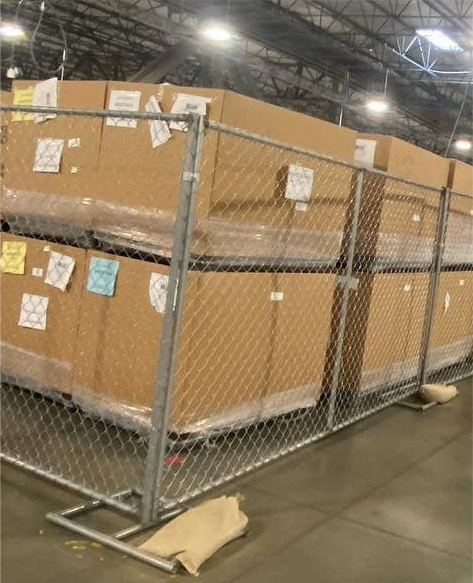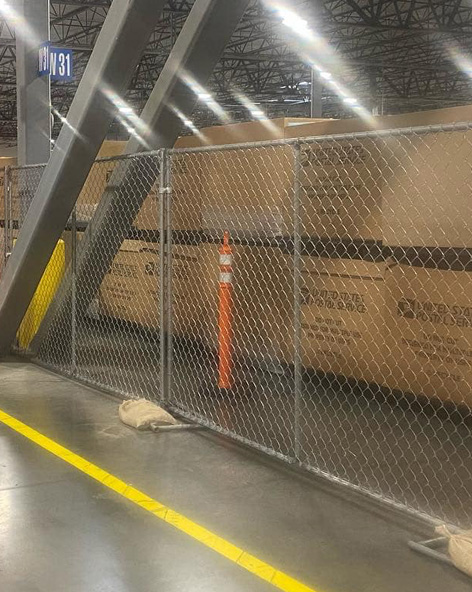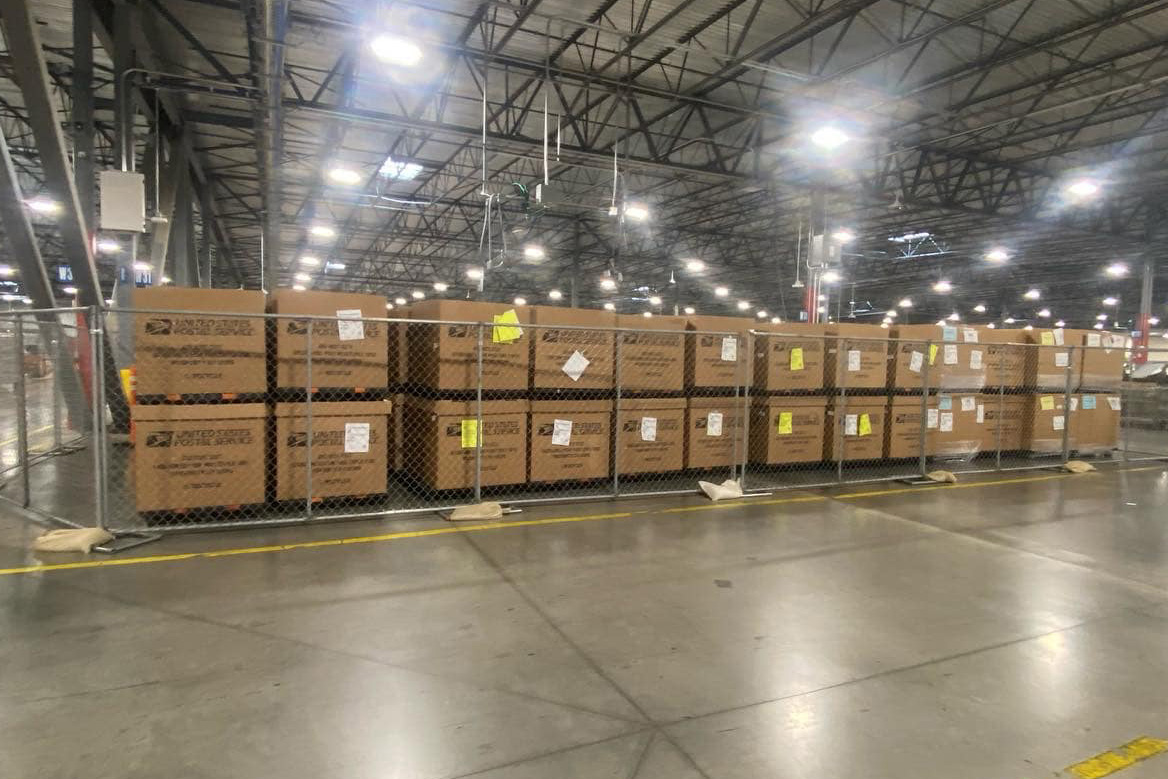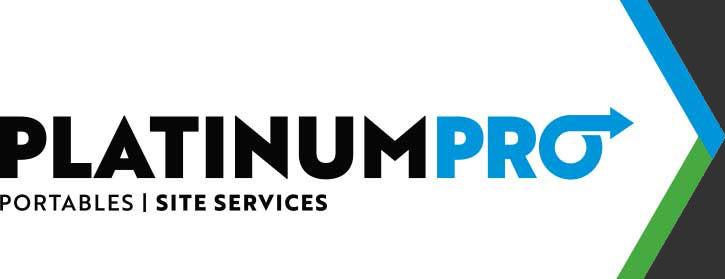Platinum Pro Portables
Temporary Fencing Rentals


Comprehensive Temporary Fence Rentals from Platinum Pro Portables
At Platinum Pro Portables, we specialize in providing comprehensive temporary fence rentals across Southern California. Our services are designed to meet the needs of various applications, ensuring the safety, security, and flexibility required for your concerts, special events, sporting events, construction sites, and any location needing temporary boundaries or a barricade. With a wide selection of temporary chain link fencing, including options for vehicle and pedestrian access gates and other accessories, we cater to both long-term and short-term rental needs.
Features and Specifications of Our Rental Fencing
Our inventory includes freestanding panels and post-driven chain link fence rentals, which can be customized with privacy screens, guards, and barbwire/razor wire for enhanced security. Available in various sizes, our chain link panel temporary fencing is perfect for construction sites, outdoor events, emergency use, and more. It is made from highly durable materials to withstand the demands of any setting.
- Chain link Panel Temporary Fencing: Available in
10’ x 6’ & 12’ x 6’, and 10’ x 8’ & 12’ x 8’ panels and
stands, with privacy screen and sandbags available
for additional stability and privacy. - Pedestrian Barricades: Measuring 90” x 42”, our
barricades provide safe, clear areas for pedestrian
traffic at events, construction sites, and emergency
operations. - White Picket Fencing: Offering a timeless, classy look for
events, our picket fencing is 48” tall and 72” wide,
perfect for delineating beer garden patio areas, lining pathways, or
adding an elegant touch to special events.
For more information on our temporary fencing rentals, please call (661) 977-1973 during regular business hours.

Versatile Applications for Every Need
Our temporary fencing services are ideal for various applications, from festivals, concerts, fairs, and carnivals to car shows, weddings, and school events. Whether you need to manage crowds, secure a construction site, or add a decorative touch to your event, our team is ready to provide tailored solutions.
Dedicated Service and Support
Platinum Pro Portables is committed to delivering the best temporary fencing rentals and exceptional service. Our experienced team is here to assist with all your public or private location rental needs, no matter the size or scope of your event.
Contact Us for Your Temporary Fencing Needs
Whether you’re planning a large festival or need to secure a construction site, our team at Platinum Pro Portables is ready to provide you with high-quality temporary fencing rentals. Contact us today to discuss your requirements and how we can support your next project with our versatile fencing options.
More About Temporary Fence Rental Solutions
Temporary Fencing
In the constantly changing environments of construction sites, event venues, and public spaces, the demand for efficient temporary fencing has become crucial. With the proliferation of projects and the increasing number of events, there has been a rise in the need for flexible and secure barriers, thus making temporary fencing an essential solution.
Whether shielding works in progress or managing large crowds at events temporary fencing stands as an emblem of security and control, embodying adaptability in a constantly changing world.
Understanding Temporary Fencing Rental
It’s essential to understand the fundamental role of temporary fencing in securing and delineating construction sites and events. Temporary barriers, including temporary fence panels, serve as a versatile solution for creating boundaries and controlling access to designated areas.
These structures offer safety and security, whether it’s a temporary privacy fence for an outdoor event or a construction site in need of fencing solutions including a gate. Temporary fences are designed to be easily installed and removed, offering a flexible option for short-term needs.
Different Types of Temporary Fencing
- Chain-Link Fencing: Durable and secure, ideal for long-term projects.
- Panel Fencing: Easy to install and move, perfect for temporary needs.
- Mesh Fencing: Offers privacy while allowing some visibility.
- Picket Fencing: Adds style to sites, though less secure, chosen for aesthetics.
Key Features of Temporary Fencing
Evaluate the key features that suit various project requirements for each type. Temporary barrier offers a sturdy construction made of a premium powder-coated finish, ideal for harsh weather conditions.
With a variety of temp fence options available, including portable fences and pedestrian barriers, you can easily secure your site. These fences are an effective solution for controlling vehicular traffic or managing crowds during events. The construction of these barriers, such as snow fences or safety netting, ensures their strength and durability.
Products like barricades for toddlers or screen mesh for privacy provide a secure solution for several applications. Choose temporary barricades for quick and easy storage and setup, making it the ideal choice for your project needs.
Applications of Rental Fencing
Temporary fencing is a versatile solution for several needs. Whether you’re securing a construction site, managing crowds at outdoor events, enclosing agricultural areas, or enhancing residential safety, temporary barricades offer a quick and effective barrier.
Construction Sites
Chain-link fencing is an ideal choice for construction sites due to its durability and versatility. It provides a secure perimeter to keep unauthorized personnel out of hazardous areas while also helping to prevent theft of materials and equipment.
The visibility offered by chain-link fencing allows for easy monitoring of the site, enhancing safety. The installation of gates within the chain-link fencing enables controlled access for authorized personnel and vehicles.
Outdoor Events
Temporary fencing provides a clear boundary, guiding attendees and helping staff manage the flow of people effectively.
Creating designated areas is key to preventing overcrowding and maintaining order throughout the event. Temporary safety fencing serves as a visual barrier, discouraging individuals from entering restricted areas or interfering with event activities. This proactive approach contributes to a safer environment for everyone involved.
Whether it’s a music festival, sporting event, or community gathering, temporary barriers offer a practical solution for maintaining crowd control. Prioritizing safety through proper crowd management not only ensures a successful event but also promotes a positive experience for attendees and staff alike.
Agricultural Uses
Fencing can help you section off different areas of your farm, preventing animals from wandering into restricted zones or trampling on delicate crops. Temporary fencing also acts as a deterrent to pests and predators, safeguarding your agricultural investments.
Setting up fencing around specific areas enables the control of grazing patterns, thereby allowing vegetation to regrow in designated sections. Fencing serves as a visual barrier, helping to guide livestock and prevent them from straying into potentially hazardous areas.
Residential Uses
A temporary fence can be a versatile solution for residential uses. Whether you need to section off a part of your yard for a specific project, create a safe play area for children or pets, or add a temporary boundary for a special event, a temporary fence offers a quick and easy setup. These fences are often lightweight, portable, and customizable to fit your specific needs.
Temporary fences can be aesthetically pleasing, with options like decorative panels or colorful designs that can improve the look of your property while providing the necessary security and peace of mind.
Materials Used In Temp Fencing
A variety of materials are utilized in temporary fencing, including metal, plastic, wood, and composite options. Each material offers distinct advantages depending on your specific needs and circumstances.
Metal Temporary Fencing
The most common types of steel used include galvanized steel, which is coated with zinc to prevent rust and corrosion, and stainless steel, known for its resistance to rust and ability to withstand harsh environments. These steel materials provide a sturdy barrier that can be easily installed and removed as needed for temporary fencing needs.
Their robust nature ensures that the fencing can withstand external forces and maintain its integrity over time. Opting for steel materials guarantees a reliable and long-lasting solution for your temporary fencing requirements when choosing metal temporary fencing.
Plastic Temporary Fencing
Plastic temporary fencing commonly utilizes polyethylene as the primary material due to its lightweight and flexible properties. Polyethylene is a durable plastic that’s resistant to weathering, making it ideal for outdoor use.
The plastic panels are often interlocked to create a sturdy barrier that can be easily moved and adjusted as needed. This type of fencing is popular for events, construction sites, and crowd control due to its quick setup and takedown.
Polyethylene is recyclable, making it an environmentally friendly choice for temporary fencing needs. Plastic fencing offers a cost-effective and versatile solution for a variety of applications when considering temporary fencing options.
Wood Temporary Fencing
Wood is commonly chosen as a temporary fencing material owing to its durability and natural aesthetic appeal. Wood temporary fencing provides a sturdy barrier that can withstand several weather conditions, making it suitable for outdoor events, construction sites, and crowd control.
The natural look of wood blends well with outdoor surroundings, offering an attractive fencing solution. Wood panels are easy to install and can be customized to fit different lengths and heights based on specific needs.
Composite Temporary Fencing
Composite temporary fencing offers a durable and low-maintenance solution for your projects. These materials are a combination of wood fibers, plastics, and other recycled materials, providing strength and longevity. Below is a comparison table highlighting the benefits of composite temporary fencing:
| Benefits | Composite Temporary Fencing |
| Durability | High |
| Maintenance | Low |
| Eco-Friendly | Yes |
| Weather Resistance | Excellent |
| Longevity | Extended lifespan |
Choosing composite materials for your temporary fencing can ensure a sturdy barrier that withstands weather conditions while being environmentally conscious.
Installation And Removal of Temporary Fences
Follow the steps carefully to ensure a secure perimeter when installing temporary fencing, prioritizing safety by taking necessary precautions. Be prepared for removal by understanding the proper procedures.
Temporary Fencing Installation Steps
To install a temporary barrier, begin by selecting a suitable location and ensuring the area is clear of obstacles. Measure the perimeter where the fencing will be placed, and mark the spots for the fence posts. Dig holes for the posts, ensuring they’re deep and wide enough for stability. Install the posts securely by filling the holes with concrete or gravel.
Once the posts are set, attach the fencing panels to the posts using zip ties or clamps. Make sure the panels are aligned and secure.
To remove the temporary fencing, simply reverse the installation steps. Remove the panels, detach them from the posts, and carefully take out the posts from the ground. Store the fencing components properly for future use.
Safety Measures During Installation
Ensure the safety of your installation and removal processes for temporary fencing by prioritizing caution and adherence to proper procedures. Before starting, survey the area for any hazards like underground utilities. Use appropriate personal protective equipment such as gloves and safety glasses.
Ensure the base is secure and the panels are correctly connected when setting up the temporary fencing. Avoid overreaching or standing on unstable surfaces.
During removal, dismantle the fencing carefully to prevent accidents. Store the panels in a designated area to avoid tripping hazards. Regularly inspect the fencing for any damage that could compromise safety.
Process of Removing Temporary Fencing
Start by identifying the sections that were put up first during installation, as these are typically the last to be removed. Remove any ties or fastenings carefully to avoid sudden collapses. If the fencing is secured with concrete blocks, use caution when detaching them to prevent injury.
Stack the panels or sections neatly as you disassemble them, keeping them organized for efficient storage. Inspect each piece for damage or wear and tear, repairing or replacing as needed.
Legal and Regulatory Considerations
Consider local laws and regulations, the environmental impact, and the sustainability of fencing materials when setting up temporary fencing to ensure compliance and prevent accidents or liabilities.
Local Laws and Regulations
Before setting up your temporary fence, research the specific regulations in your area regarding fencing height, materials, and placement. Some local laws may require a permit for temporary fencing, especially if it will be in place for an extended period.
Be mindful of any restrictions on the type of fencing allowed, such as barbed wire or electric fencing, as these may be prohibited in certain locations. Failure to comply with local laws and regulations could result in citations, removal of the fence, or other legal consequences.
Environmental Impact and Sustainability
Ensure that the materials used in the fencing are eco-friendly and don’t harm the surrounding environment.
Check if there are any specific regulations regarding the type of fencing allowed in the area, especially in environmentally sensitive zones. Look into the disposal process of the fencing materials after use to ensure they’re recycled or disposed of properly.
Adhering to sustainability practices not only benefits the environment but also helps you comply with legal requirements. Being mindful of the environmental impact of temporary fencing and following regulations contributes to a more sustainable and eco-conscious approach to your projects.
Health and Safety Regulations
Ensure that temporary fencing installations adhere to all relevant health and safety regulations. Before setting up any temporary fencing, confirm that it meets local legal requirements. Make sure that the fencing is securely installed to prevent accidents or unauthorized access to restricted areas.
Regularly inspect the fencing for any damage or weaknesses that could compromise its effectiveness. Provide clear signage indicating any potential hazards or safety precautions that need to be taken around the fencing area. Train all staff involved in the installation and maintenance of temporary fencing on proper safety procedures.
Cost and Budgeting for Temporary Fencing
To effectively manage your budget for temporary fencing, consider various elements influencing its cost and implement smart tips. Comparing the expenses of different types of temporary fencing aids in making informed decisions.
Factors Affecting Temporary Fencing Costs
To calculate the total expenses for temporary fencing, consider the factors that impact the cost and budgeting for this project.
The type of fencing material used plays a significant role in determining costs; chain-link fencing is usually more budget-friendly than options like steel or vinyl.
The size of the area requiring fencing will also influence the total cost, as larger areas will necessitate more materials and labor.
The duration of the fencing needs is crucial; longer rental periods will increase the total expense.
Other factors to consider include the need for gates, any customization or special requirements, and the location for installation, which may affect labor costs.
Budgeting Tips to Rent Temporary Fences
Considering the factors influencing the cost of temporary fencing, you can effectively manage your budget by implementing practical budgeting tips. Start by outlining the specific needs of your project to determine the quantity and type of fencing required.
Research suppliers to compare prices and quality, allowing you to find the best deal that fits your budget. Opting for rental options can often be more cost-effective for short-term projects, saving you money on purchasing new fencing.
Consider the duration of your project and choose a rental period that aligns with your timeline to avoid unnecessary costs. Planning, conducting thorough research, and being mindful of your project needs can help you successfully budget for temporary fencing without overspending.
Cost Comparison of Different Types of Temporary Fencing
To make an informed decision about temporary fencing options, it’s essential to weigh the costs against the benefits to find the best fit for your budget.
Here is a breakdown to help you compare costs effectively:
- Chain Link Fencing:
- Initial Cost: $2 – $40
- Maintenance: Low
- Durability: High
- Wire Mesh Fencing:
- Initial Cost: $3.60 – $9.80 per foot for residential chain-link fencing
- Maintenance: Low to Medium
- Durability: Medium
- Panel Fencing:
- Initial Cost: Higher, ranging from $10 to $50 per linear foot for wood fencing
- Maintenance: Low
- Durability: High
Maintenance and Durability of Temporary Fencing
Factors like weather conditions and material quality can impact how durable your fencing is.
Knowing how to maintain, repair, and replace sections when needed will help keep your temporary fencing in top condition.
Maintenance Tips for Temporary Fencing
To ensure the longevity of your temporary fencing, regularly inspect the panels for any signs of damage or wear. Check for loose connections or bent components that may compromise the stability of the fence. Keep the base of the fence clear from debris and vegetation to prevent corrosion and maintain structural integrity.
If you notice any issues during your inspection, promptly repair or replace damaged parts to prevent further deterioration. Consider adding extra support or reinforcements in high-traffic areas to increase the durability of the fencing.
Factors Affecting the Durability of Temporary Fencing
Inspecting your temporary fencing regularly can significantly impact its durability and longevity. Through conducting routine checks, you can identify any damage, corrosion, or loose components promptly. Addressing these issues immediately can prevent them from escalating and potentially compromising the stability of your fencing.
Cleaning your temporary fencing regularly, especially in areas prone to dirt buildup or corrosive materials, can help maintain its structural integrity. Proper storage when not in use also plays a crucial role in prolonging the lifespan of your fencing.
Repair and Replacement of Temporary Fencing
Regularly checking your temporary fencing for damage, corrosion, or loose components is essential for maintaining its durability and longevity. Address any issues promptly to prevent further deterioration and ensure the effectiveness of the fencing.
When damage is identified, repair or replace the affected sections promptly. Use high-quality materials for repairs to uphold the structural integrity of the fencing. Consider applying rust-resistant coatings or treatments to prevent corrosion and extend the lifespan of the fencing.
Proper maintenance not only improves the appearance of the fencing but also contributes to its comprehensive strength and effectiveness. To ensure your temporary fencing continues to serve its purpose effectively for an extended period, stay proactive and address repairs promptly.
Choosing the Right Temporary Fencing
Consider factors such as location, purpose, and desired security level when selecting the right temporary fencing. Each type has its pros and cons, so weigh them against your needs. Tailored recommendations for several use cases can guide your decision-making process effectively.
Factors to Consider When Choosing Temporary Fencing
Consider your specific needs and requirements when selecting temporary fencing for your project. Start by evaluating the level of security needed. If you require high security, consider anti-climb fencing with added features like barbed wire or privacy screening.
Assess the duration of the project. For short-term projects, chain-link fencing may suffice, while long-term projects may benefit from more durable options like steel hoarding.
Think about the terrain where the fencing will be installed. The uneven ground may require fencing with adjustable panels or stabilizers.
Consider any aesthetic requirements or regulations that may impact your choice. Carefully considering these factors will enable you to select the right temporary fencing solution for your project.
Pros and Cons of Temporary Fencing Types
Assessing the pros and cons of different types of temporary fencing is crucial for choosing the right option for your project.
Chain-link fencing offers durability and visibility, making it suitable for construction sites; it might not provide the desired level of privacy.
Mesh fencing is lightweight and easy to install, ideal for events, but it may lack the sturdiness needed for long-term use.
Panel fencing is versatile and secure, making it a good choice for crowd control, yet it can be more expensive compared to other options.
Your decision should be based on factors such as the purpose of the fencing, duration of use, budget, and specific requirements of your project.
Recommendations for Different Use Cases
Choose the appropriate temporary fencing by matching your project requirements with available options. For construction sites needing high security, consider chain-link fencing with added features like barbed wire. Events and crowd control may benefit from barricades or mesh fencing for visibility.
If you require privacy, go for temporary fences. For projects in windy areas, windscreen fencing can reduce wind resistance. When aesthetics matter, pick ornamental fencing. Temporary fencing with gates is essential for areas needing easy access.
Always prioritize safety by ensuring the fencing is sturdy and meets any regulatory requirements. Aligning your needs with the right temporary fencing features can ensure a successful project.
Frequently Asked Questions
Is Temporary Fencing Suitable for Events in Extreme Weather Conditions?
Yes, temporary fencing can be used for events in extreme weather conditions if properly secured. Assess the weather forecast beforehand, reinforce the fencing as needed, and ensure it meets safety standards for the event.
Are There Any Eco-Friendly Options for Temporary Fencing Materials?
When considering eco-friendly options for temporary fencing materials, you can navigate sustainable choices like bamboo, recycled plastic, or metal. These alternatives offer durability without compromising the environment, making them ideal for a wide range of purposes.
How Can Temporary Fencing Be Customized for Specific Security Needs?
To customize temporary fencing for specific security needs, you can add features like barbed wire, privacy screens, or motion sensors. Adjusting height, material, and lock systems ensures your fencing meets your unique security requirements.
Is There a Maximum Height Restriction for Temporary Fencing in Residential Areas?
In residential areas, the maximum height restriction for fencing varies. Local regulations typically dictate the limit to ensure safety and aesthetic harmony. Before installation, it’s wise to research and adhere to these guidelines.
Are There Any Specific Permits Required for Installing Temporary Fencing on Public Property?
To install temporary fencing on public property, you usually need specific permits. Check with your local authorities to ensure compliance. Make sure to obtain the necessary paperwork before setting up the fencing.
| Related Term | Definition |
|---|---|
| Grade steel construction | Construction using steel materials graded according to their strength, durability, and other mechanical properties. |
| Mobile barriers | Barriers or partitions that can be easily moved or repositioned, typically used for traffic control, security, or crowd management purposes. |


